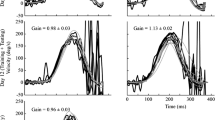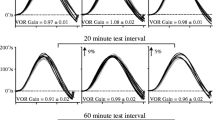Abstract
The primary function of the angular vestibulo-ocular reflex (VOR) is to stabilise images on the retina during head movements. Retinal image movement is the likely feedback signal that drives VOR modification/adaptation for different viewing contexts. However, it is not clear whether a retinal image position or velocity error is used primarily as the feedback signal. Recent studies examining this signal are limited because they used near viewing to modify the VOR. However, it is not known whether near viewing drives VOR adaptation or is a pre-programmed contextual cue that modifies the VOR. Our study is based on analysis of the VOR evoked by horizontal head impulses during an established adaptation task. Fourteen human subjects underwent incremental unilateral VOR adaptation training and were tested using the scleral search coil technique over three separate sessions. The update rate of the laser target position (source of the retinal image error signal) used to drive VOR adaptation was different for each session [50 (once every 20 ms), 20 and 15/35 Hz]. Our results show unilateral VOR adaptation occurred at 50 and 20 Hz for both the active (23.0 ± 9.6 and 11.9 ± 9.1 % increase on adapting side, respectively) and passive VOR (13.5 ± 14.9, 10.4 ± 12.2 %). At 15 Hz, unilateral adaptation no longer occurred in the subject group for both the active and passive VOR, whereas individually, 4/9 subjects tested at 15 Hz had significant adaptation. Our findings suggest that 1–2 retinal image position error signals every 100 ms (i.e. target position update rate 15–20 Hz) are sufficient to drive VOR adaptation.



Similar content being viewed by others
References
Aw ST, Haslwanter T, Halmagyi GM, Curthoys IS, Yavor RA, Todd MJ (1996) Three-dimensional vector analysis of the human vestibuloocular reflex in response to high-acceleration head rotations I. Responses in normal subjects. J Neurophysiol 76:4009–4020
Black RA, Halmagyi GM, Thurtell MJ, Todd MJ, Curthoys IS (2005) The active head-impulse test in unilateral peripheral vestibulopathy. Arch Neurol 62:290–293
Chim D, Lasker DM, Migliaccio AA (2013) Visual contribution to the high-frequency human angular vestibulo-ocular reflex. Exp Brain Res 230:127–135
Della Santina CC, Cremer PD, Carey JP, Minor LB (2002) Comparison of head thrust test with head autorotation test reveals that the vestibulo-ocular reflex is enhanced during voluntary head movements. Arch Otolaryngol Head Neck Surg 128:1044–1054
Diggle PJ, Liang KY, Zeger SL (1994) Analysis of longitudinal data. Oxford University Press, New York
Eggers SD, De Pennington N, Walker MF, Shelhamer M, Zee DS (2003) Short-term adaptation of the VOR: non-retinal-slip error signals and saccade substitution. Ann N Y Acad Sci 1004:94–110
Gauthier GM, Robinson DA (1975) Adaptation of human’s vestibulo-ocular reflex to magnifying glasses. Brain Res 92:331–335
Gonshor A, Jones GM (1976a) Short-term adaptive changes in the human vestibulo-ocular reflex arc. J Physiol 256:361–379
Gonshor A, Jones GM (1976b) Extreme vestibulo-ocular adaptation induced by prolonged optical reversal of vision. J Physiol 256:381–414
Grossman GE, Leigh RJ, Abel LA, Lanska DJ, Thurston SE (1988) Frequency and velocity of rotational head perturbations during locomotion. Exp Brain Res 70:470–476
Halmagyi GM, Curthoys IS (1988) A clinical sign of canal paresis. Arch Neurol 45:737
Han YH, Kumar AN, Reschke MF, Somers JT, Dell’Osso LF, Leigh RJ (2005) Vestibular and non-vestibular contributions to eye movements that compensate for head rotations during viewing of near targets. Exp Brain Res 165:294–304
Haslwanter T (1995) Mathematics of three-dimensional eye rotations. Vision Res 35:1727–1739
Hecht S, Shlaer S (1936) Intermittent stimulation by light V. The relation between intensity and critical frequency for different parts of the spectrum. J Gen Physiol 19:965–977
Hepp K (1990) On Listing’s Law. Commun Math Phys 132:285–292
Ito M (1975) Learning control mechanisms by the cerebellum investigated in the flocculo-vestibulo-ocular system. The nervous system. (Ed.) Tower DB Volume 1. The basic neurosciences. Raven Press, New York, p. 245-252
Jones GM (1985) Adaptive modulation of VOR parameters by vision. Rev Oculomot Res 1:21–50
Lewis RF (2003) Context-dependent adaptation of visually-guided arm movements and vestibular eye movements: role of the cerebellum. Cerebellum 2:123–130
Lewis RF, Clendaniel RA, Zee DS (2003) Vergence-dependent adaptation of the vestibulo-ocular reflex. Exp Brain Res 152:335–340
Migliaccio AA, Schubert MC (2013) Unilateral adaptation of the human angular vestibulo-ocular reflex. J Assoc Res Otolaryngol 14:29–36
Migliaccio AA, Schubert MC (2014) Pilot study of a new rehabilitation tool: improved unilateral short-term adaptation of the human angular vestibulo-ocular reflex. Otol Neurotol 35:310–316
Migliaccio AA, Todd MJ (1999) Real-time rotation vectors. Australas Phys Eng Sci Med 22:73–80
Migliaccio AA, Cremer PD, Aw ST, Halmagyi GM, Curthoys IS, Minor LB, Todd MJ (2003) Vergence-mediated changes in the axis of eye rotation during the human vestibulo-ocular reflex can occur independent of eye position. Exp Brain Res 151:238–248
Miles FA, Eighmy BB (1980) Long-term adaptive changes in primate vestibuloocular reflex. I. Behavioral observations. J Neurophysiol 43:1406–1425
Paige G, Sargent E (1991) Visually-induced adaptive plasticity in the human vestibulo-ocular reflex. Exp Brain Res 84:25–34
Paige GD, Seidman SH (1999) Characteristics of the VOR in response to linear acceleration. Ann N Y Acad Sci 871:123–135
Paige GD, Telford L, Seidman SH, Barnes GR (1998) Human vestibuloocular reflex and its interactions with vision and fixation distance during linear and angular head movement. J Neurophysiol 80:2391–2404
Schubert MC, Della Santina CC, Shelhamer M (2008) Incremental angular vestibulo-ocular reflex adaptation to active head rotation. Exp Brain Res 191:435–446
Shelhamer M, Robinson DA, Tan HS (1992) Context-specific adaptation of the gain of the vestibulo-ocular reflex in humans. J Vestib Res 2:89–96
Straumann D, Zee DS, Solomon D, Lasker AG, Roberts DC (1995) Transient torsion during and after saccades. Vision Res 35:3321–3334
Viirre E, Tweed D, Milner K, Vilis T (1986) A reexamination of the gain of the vestibuloocular reflex. J Neurophysiol 56:439–450
Watson AB (1990) Optimal displacement in apparent motion and quadrature models of motion sensing. Vision Res 30:1389–1393
Watson AB, Ahumada AJ, Farrell JE (1986) Window of visibility: a psychophysical theory of fidelity in time-sampled visual motion displays. J Opt Soc Am 3:300–307
Yakushin SB, Raphan T, Cohen B (2000) Context-specific adaptation of the vertical vestibulo-ocular reflex with regard to gravity. J Neurophysiol 84:3067–3071
Acknowledgments
A. A. Migliaccio was supported by The Garnett Passe and Rodney Williams Memorial Foundation Senior/Principal Research Fellowship in Otorhinolaryngology.
Author information
Authors and Affiliations
Corresponding author
Rights and permissions
About this article
Cite this article
Fadaee, S.B., Migliaccio, A.A. The effect of retinal image error update rate on human vestibulo-ocular reflex gain adaptation. Exp Brain Res 234, 1085–1094 (2016). https://doi.org/10.1007/s00221-015-4535-y
Received:
Accepted:
Published:
Issue Date:
DOI: https://doi.org/10.1007/s00221-015-4535-y




